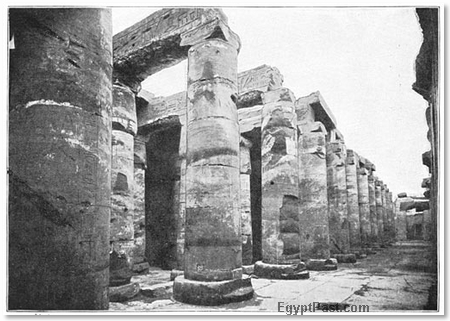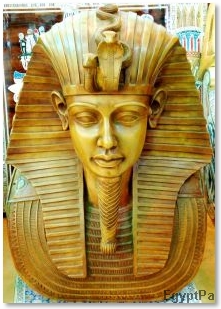MILITARY

Ruins of an Ancient Egyptian Temple
Military.—In the earliest periods there was no standing army, because of the nature of the people and of the peculiar organization of the kingdom. Each nomos had its own militia and each temple its soldiers, who appear rather to have been police. This arrangement continued through the Middle Kingdom. The chief service rendered by the soldiers in these periods was to escort expeditions to the quarries of SYENE and HAMMAMAT (q. v.), and to the mines of Sinai and Nubia. They also rendered service as laborers.
The most important military expedition undertaken in the Old Kingdom was that of Pepi (sixth dynasty) against the Beduin of the east. The army consisted largely of Ethiopian mercenaries under Una, a judge-general, but it required five expeditions to reduce the "people dwelling on the sand" to subjection. (See Records of the Past, ser. 2, vol. ii., p.'1 ff.) This use of mercenaries characterized the whole of Egyptian history.

The Gold Covering of a Sarcophagous
The expeditions of Amenemha III. (twelfth dynasty) to Nubia mark the next stage of foreign warlike operations. A stele of this period in Berlin mentions the wailing which attended the visits of the conscripting officer, the "military scribe" who came "to choose out the likely youth." A new feature of the period is in the body-guard which surrounded the king, a sign of a more developed royalty. The long contest with the Hyksos educated the warlike spirit of Egypt, at least so far as the upper classes were concerneds The armies, however, appear to have been composed of mercenaries in the main, while conscription was little employed.
This practice became more and more fixed in later times. A body of troops employed during the nineteenth dynasty contained 1,900 natives and 3,100 foreigners. At first the foreigners were officered by Egyptians. A principal service required of the soldiery was police duty as gendarmes. Nadal was the special name of the bowmen in the Old Kingdom, and they seem to have been foreigners. In the New Kingdom this name became the ordinary designation of "soldiers." They had their own generals and they played an increasingly important role.
The chariot came into use at or after the Hyksos wars, and was constructed to contain two persons, driver and warrior. Border garrisons were maintained to the east and south. The ancient insignia of the warrior were two feathers on the head, a mark supposed to have been of foreign origin and used to denote foreign troops.
The bow was also foreign, and held in lower esteem than the native weapons—the spear and shield, the ax, lance, dagger, and sling. The earliest clothing of the soldier consisted of the simple apron, and was only slowly replaced by the helmet and wadded garments. Naval warfare was little practiced, though it was necessary against the Hyksos on the Nile, and again later against "the inhabitants of the islands," whom Ramses III. drove back from the Nile mouths.
pyramids Egypt Mummies Search Engines Link Report
Egyptian Cities | Egyptian Education | Ancient Egypt | egyptian clothing | Egyptian Houses | The Egyptians | Egyptian Family Life | Egypt and its Neighbours | Government in Ancient Egypt | Egyptian History | Military | Organization of Ancient Egypt | Recreation | Egyptian Religion | Pyramids | About | Privacy Policy | Site News | Site Map
EgyptPast.com - Facts and Information About the History of Ancient Egypt
-